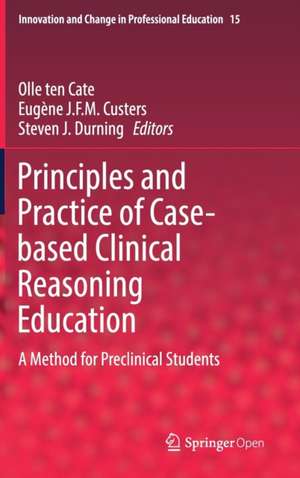Principles and Practice of Case-based Clinical Reasoning Education: A Method for Preclinical Students: Innovation and Change in Professional Education, cartea 15
Editat de Olle ten Cate, Eugène J.F.M. Custers, Steven J. Durningen Limba Engleză Hardback – 17 noi 2017
This book is open access under a CC BY 4.0 license.
| Toate formatele și edițiile | Preț | Express |
|---|---|---|
| Paperback (1) | 359.64 lei 38-45 zile | |
| Springer International Publishing – 29 aug 2018 | 359.64 lei 38-45 zile | |
| Hardback (1) | 391.02 lei 6-8 săpt. | |
| Springer International Publishing – 17 noi 2017 | 391.02 lei 6-8 săpt. |
Din seria Innovation and Change in Professional Education
- 15%
 Preț: 634.49 lei
Preț: 634.49 lei -
 Preț: 358.27 lei
Preț: 358.27 lei - 24%
 Preț: 804.96 lei
Preț: 804.96 lei - 18%
 Preț: 947.18 lei
Preț: 947.18 lei - 24%
 Preț: 689.09 lei
Preț: 689.09 lei - 18%
 Preț: 1334.36 lei
Preț: 1334.36 lei - 18%
 Preț: 898.58 lei
Preț: 898.58 lei - 18%
 Preț: 1014.76 lei
Preț: 1014.76 lei - 18%
 Preț: 948.29 lei
Preț: 948.29 lei - 15%
 Preț: 642.51 lei
Preț: 642.51 lei - 18%
 Preț: 1123.98 lei
Preț: 1123.98 lei - 15%
 Preț: 642.36 lei
Preț: 642.36 lei - 15%
 Preț: 634.32 lei
Preț: 634.32 lei - 15%
 Preț: 636.80 lei
Preț: 636.80 lei - 18%
 Preț: 778.13 lei
Preț: 778.13 lei - 15%
 Preț: 640.71 lei
Preț: 640.71 lei - 15%
 Preț: 639.73 lei
Preț: 639.73 lei -
 Preț: 378.64 lei
Preț: 378.64 lei
Preț: 391.02 lei
Nou
Puncte Express: 587
Preț estimativ în valută:
74.82€ • 78.12$ • 61.92£
74.82€ • 78.12$ • 61.92£
Carte tipărită la comandă
Livrare economică 04-18 aprilie
Preluare comenzi: 021 569.72.76
Specificații
ISBN-13: 9783319648279
ISBN-10: 3319648276
Pagini: 207
Ilustrații: X, 207 p. 14 illus.
Dimensiuni: 155 x 235 mm
Greutate: 0.49 kg
Ediția:1st ed. 2018
Editura: Springer International Publishing
Colecția Springer
Seria Innovation and Change in Professional Education
Locul publicării:Cham, Switzerland
ISBN-10: 3319648276
Pagini: 207
Ilustrații: X, 207 p. 14 illus.
Dimensiuni: 155 x 235 mm
Greutate: 0.49 kg
Ediția:1st ed. 2018
Editura: Springer International Publishing
Colecția Springer
Seria Innovation and Change in Professional Education
Locul publicării:Cham, Switzerland
Cuprins
PART I: Backgrounds of educating preclinical students in clinical reasoning.- 1. Introduction; Olle ten Cate.- 2. Training clinical reasoning: historical and theoretical background; Eugène J.F.M. Custers.- 3. Understanding clinical reasoning from multiple perspectives: a conceptual and theoretical overview; Olle ten Cate & Steven Durning.- 4. Prerequisites for Learning Clinical Reasoning; Judith L. Bowen & Olle ten Cate.- 5. Approaches to assessing the clinical reasoning of preclinical students; Olle ten Cate & Steven J. Durning.- PART II: The method of Case-Based Clinical Reasoning education.- 6. Case-based Clinical Reasoning in practice; Angela van Zijl, Maria van Loon & Olle ten Cate.- 7. Assessment of clinical reasoning in a CBCR course; Olle ten Cate.- 8. Writing CBCR cases; Olle ten Cate & Maria van Loon.- 9. Curriculum and faculty development for Case-based Clinical Reasoning; Olle ten Cate & Gaiane Simonia.- 10. A model study guide for Case-based Clinical Reasoning; Maria van Loon, Sjoukje van den Broek & Olle ten Cate.- PART III: Appendices: Case 1: A 17-year old girl with a swelling in the neck; Case 2: A 68-year old man with swollen leg; Case 3: A 47-year old woman with fatigue; Case 4: Two patients with hearing loss.
Textul de pe ultima copertă
This book is open access under a CC BY 4.0 license.
This volume describes and explains the educational method of Case-Based Clinical Reasoning (CBCR) used successfully in medical schools to prepare students to think like doctors before they enter the clinical arena and become engaged in patient care. Although this approach poses the paradoxical problem of a lack of clinical experience that is so essential for building proficiency in clinical reasoning, CBCR is built on the premise that solving clinical problems involves the ability to reason about disease processes. This requires knowledge of anatomy and the working and pathology of organ systems, as well as the ability to regard patient problems as patterns and compare them with instances of illness scripts of patients the clinician has seen in the past and stored in memory. CBCR stimulates the development of early, rudimentary illness scripts through elaboration and systematic discussion ofthe courses of action from the initial presentation of the patient to the final steps of clinical management.
The book combines general backgrounds of clinical reasoning education and assessment with a detailed elaboration of the CBCR method for application in any medical curriculum, either as a mandatory or as an elective course. It consists of three parts: a general introduction to clinical reasoning education, application of the CBCR method, and cases that can used by educators to try out this method.Caracteristici
Is an easily accessible overview of the backgrounds and history of clinical reasoning education Covers approaches to the assessment of clinical reasoning ability Describes a method that can be applied in any medical school Aligns with current thinking about student-centered, active, modern medical education
